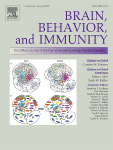Biological Motion During Inflammation in Humans
Brain, Behavior, and Immunity
Collaborative members Peter Wayne, Mats Olsson, John Axelsson, and Matts Lekander with Julie Lasselin, Tina Sundelin, and Sofie Paues-Göranson. Published November 27, 2019.
Brain, Behavior, and Immunity. 2019 Nov 27.
Abstract
Biological motion is a powerful perceptual cue that can reveal important information about the inner state of an individual. Activation of inflammatory processes likely leads to changes in gait, posture, and mobility patterns, but the specific characteristics of inflammation-related biological motion have not been characterized. The aim of this study was to determine the effect of inflammation on gait and motion in humans. Systemic inflammation was induced in 19 healthy volunteers with an intravenous injection of lipopolysaccharide (2 ng/kg body weight). Biological motion parameters (walking speed, stride length and time, arm, leg, head, and shoulder angles) were assessed during a walking paradigm and the timed-up-and-go test. Cytokine concentrations, body temperature, and sickness symptoms were measured. During inflammation, compared to placebo, participants exhibited shorter, slower, and wider strides, less arm extension, less knee flexion, and a more downward-tilting head while walking. They were also slower and took a shorter first step in the timed-up-and-go test. Higher interleukin-6 concentrations, stronger sickness symptoms, and lower body temperature predicted the inflammation-related alterations in biological motion. These findings show that biological motion contains clear information about the inflammatory status of an individual, and may be used by peers or artificial intelligence to recognize that someone is sick or contagious.

